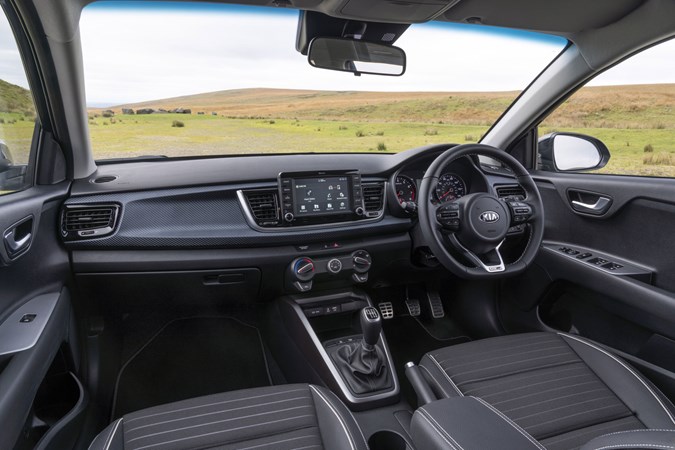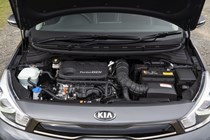Kia Rio Hatchback (2017-2023) review

At a glance
| Price new | £12,785 - £22,620 |
|---|---|
| Used prices | £4,206 - £20,128 |
| Road tax cost | £20 - £195 |
| Insurance group | 2 - 10 |
Get an insurance quote with

|
|
| Fuel economy | 41.5 - 54.3 mpg |
| Range | 436 - 792 miles |
| Miles per pound | 6.1 - 8.0 |
| Number of doors | 5 |
| View full specs for a specific version | |
Available fuel types
Petrol
Diesel
Pros & cons
- Seven-year warranty
- Practical, solid interior
- Plenty of standard kit
- A bit dull to drive
- Not cheap enough
- Doesn’t stand out
Kia Rio Hatchback (17-23) rivals
Overview
The Rio is Kia’s rival to some very talented, established supermini rivals – an area of the car market that’s swamped with options that regularly find their way on to lists of the bestselling cars in the UK. It sits between the Picanto and Ceed in the firm’s line-up.
But it needs to be good to steal attention away from its many and varied rivals. The Ford Fiesta is one of our favourite superminis along with the SEAT Ibiza, while new versions of the Vauxhall Corsa, Renault Clio and Peugeot 208 all impress.
The Rio is more about good value and comfort, and so cars it also needs to beat include the Hyundai i20, Toyota Yaris, Suzuki Swift and Citroen C3.
That’s quite a long list, but it’s off to a good start with one of the biggest boots of them all, lots of standard equipment and Kia’s enticing seven-year warranty.

Solid and spacious interior
The Rio’s interior is just as grown up as its exterior styling. In fact, it looks pleasantly attractive without looking over the top, with neat details like a freestanding media system, air-con controls that look like toggle switches, some nice seat materials and a nice wheel.
It doesn’t have the highest-quality feel though, at least compared with rivals. There’s no question how solidly-built it looks and feels, but some of the materials are quite hard, with only the higher-spec models coming with some softer materials. It’s quite similar to the SEAT Ibiza in this regard, in that it’s very sensitive to which spec you choose.
It’s plenty roomy enough though, with just about enough space for four adults, while the boot is one of the largest in the supermini class.
Good choice of engines and trim levels
It’s an all-petrol line-up for the Rio, with three engines delivering four different power outputs and a selection of gearbox options. There’s an entry-level 1.25-litre with 82hp, a 97hp 1.4 and a 1.0-litre three-cylinder turbo in a choice of 98bhp or 116hp. The 1.25 and lower-output 1.0-litre turbo are manual-only, while the other two come with a choice of manual or automatic transmissions.

The familiar choice of Kia trim levels are available for the Rio, kicking off with the 1, moving up through 2 and 3 on to GT-Line and GT-Line S options. The Rio 1 is fairly sparsely-equipped, so we’d suggest going for at least the 2 for a good amount of kit including a touchscreen media system with DAB radio and Apple CarPlay and Android Auto, plus useful kit like a reversing camera and rear parking sensors.
GT-Line and GT-Line S cars up the kerb appeal with a sportier look, with the top model coming fully-specced with the kind of kit you’ll find on more expensive Ceed models, but it’s not especially cheap to buy.
Easy to drive, but a bit dull
The Rio is all about ease of use, and it’s a simple machine to just get in and drive. The controls are all logically laid out and it’s easy to get comfortable, and light steering and pedals make things easy on the move.
And while that all means it’s a great companion around town, it’s not as interesting to drive as a Ford Fiesta or Mazda 2, but it does impress as a quiet and comfortable supermini.
Read on for the full verdict on the Kia Rio supermini.







.jpg)
.jpg)
.jpg)
.jpg)
.jpg)
.jpg)
.jpg)
.jpg)
.jpg)









.jpg)
.jpg)
.jpg)
.jpg)
.jpg)
.jpg)
.jpg)
.jpg)
.jpg)



.jpg)
.jpg)
.jpg)
.jpg)
.jpg)
.jpg)
.jpg)
.jpg)
.jpg)
.jpg)




.jpg)








.jpg)
.jpg)
.jpg)
.jpg)
.jpg)
.jpg)
.jpg)
.jpg)
.jpg)
.jpg)
.jpg)
.jpg)
.jpg)


.jpg)
.jpg)

.jpg)
.jpg)
.jpg)

.jpg)
.jpg)
.jpg)
.jpg)








.jpg?quality=50)
.jpg?quality=50)
.jpg?quality=50)
.jpg?quality=50)
.jpg?quality=50)
.jpg?quality=50)
.jpg?quality=50)
.jpg?quality=50)
.jpg?quality=50)









.jpg?quality=50)
.jpg?quality=50)
.jpg?quality=50)
.jpg?quality=50)
.jpg?quality=50)
.jpg?quality=50)
.jpg?quality=50)
.jpg?quality=50)
.jpg?quality=50)



.jpg?quality=50)
.jpg?quality=50)
.jpg?quality=50)
.jpg?quality=50)
.jpg?quality=50)
.jpg?quality=50)
.jpg?quality=50)
.jpg?quality=50)
.jpg?quality=50)
.jpg?quality=50)




.jpg?quality=50)








.jpg?quality=50)
.jpg?quality=50)
.jpg?quality=50)
.jpg?quality=50)
.jpg?quality=50)
.jpg?quality=50)
.jpg?quality=50)
.jpg?quality=50)
.jpg?quality=50)
.jpg?quality=50)
.jpg?quality=50)
.jpg?quality=50)
.jpg?quality=50)


.jpg?quality=50)
.jpg?quality=50)

.jpg?quality=50)
.jpg?quality=50)
.jpg?quality=50)

.jpg?quality=50)
.jpg?quality=50)
.jpg?quality=50)
.jpg?quality=50)